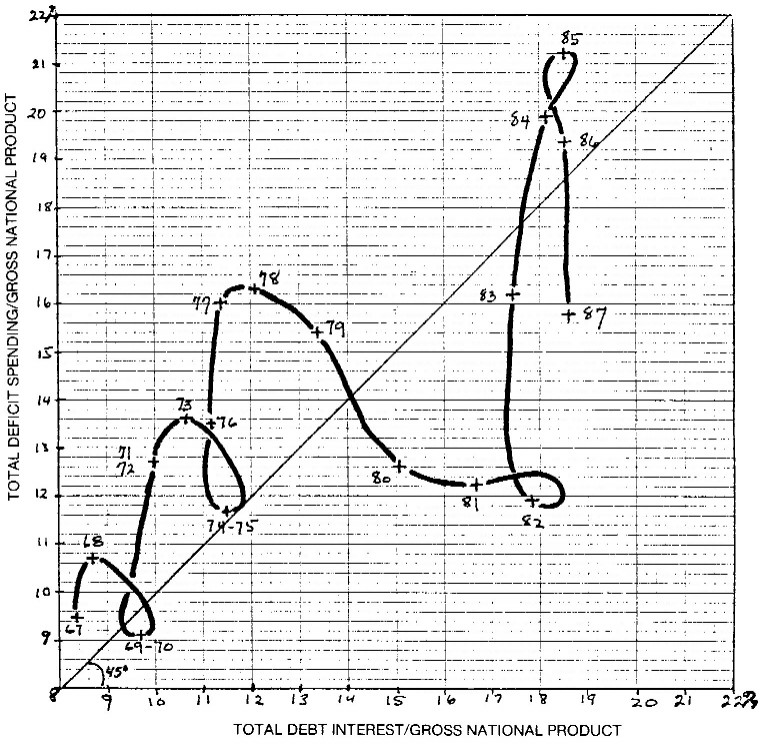
16:
The United States 1967-1987. Recessions occur when TDS/GNP < TDI/GNPHixson’s Helix: The True Inflation Spiral

Note Ever Wider Swings; Secularly Increasing Deficit Finance and Interest Payments Relative to GNP.
"Hixson's Helix" shows the wild gyrations of the U.S. economy from 1967 through 1987 in terms of borrowing and interest payments. The vertical axis of Figure 2 labelled Total Deficit Spending/Gross National Product shows the percentage of GNP which is deficit financed by all sectors public and private. The horizontal axis labelled Total Debt Interest/ Gross National Product shows interest paid as a percentage of GNP. The 45 0 line shows all possible points where TDS/GNP is just equal to TDI/GNP. Each year is indicated by a cross and the years are connected by a line, generating the helix. Several points are clear.
First, each business cycle since 1967 has involved an upswing in which for a few years society borrowed more than was needed merely to pay interest on existing debts. Then came a recession in which borrowing decreased to merely equal, or less than equal, interest payments.
Second, in each cycle TDS and TDI became larger and larger fractions of GNP. At the 1968 peak Americans borrowed 10.7% of GNP, and paid 8.7% in interest, but in 1985 they borrowed 21.2% of GNP, and paid 18.5% of GNP in interest.
Third, the 1979-82 downturn, caused by extortionate interest rates, resulted in four years in which Americans borrowed less than the interest on their existing debts, even though throughout the period they were borrowing a considerably higher fraction of GNP than at the 1968 peak. This downturn, by far the most severe since World War Two, also resulted in heavy unemployment and bankrupted many businesses and farms.
Fourth, the "Reagan recovery," set off by the Fed cutting interest rates in half in August 1982 to forestall Mexican default, is over, and unless interest rates are cut drastically the U.S. economy is headed toward deep recession in 1988-9.
Fifth, the U.S. economy is on a wholly unsustainable "flight path." No one knows how much of GNP can be deficit financed, and how much of its income society can devote to repayment of interest, but a limit must exist somewhere. One can't picture an economy working well where we all owe the banks so much that we have to turn over each paycheck to them as part of the interest we owe and borrow still more so we can eat and work for another week! Long before this occurs the economy must crash into a major debt repudiation depression,--perhaps after a series of ever more severe inflationary bouts, which reduce debt, and interest on debt, to manageable proportions of income.
What the U.S. needs, but lacks, are institutions and policies which would allow it to "hover," borrowing a constant percentage of GNP, and paying in interest a constant and lower percentage of GNP. Finding such institutions and policies--and getting them adopted is what C.O.M.E.R. is all about.
William F. Hixson, the discoverer of the Helix which bears his name is a member of the Board of the Committee On Monetary and Economic Reform.
[Originally appended to Item 5]